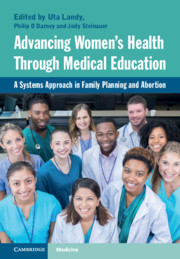 Advancing Women's Health Through Medical Education
Advancing Women's Health Through Medical Education Book contents
- Advancing Women’s Health Through Medical Education
- Reviews
- Advancing Women’s Health Through Medical Education
- Copyright page
- Dedication
- Contents
- Contributors
- Preface
- Acknowledgments
- Introduction
- Section I Abortion Training: Workforce, Leadership, Social & Political Impact
- Section II Integration of Abortion into Graduate Medical Education
- Section III Family Planning Curricular Design & Implementation
- Section IV Reproductive Health Services & Abortion Training: Global Examples
- Chapter 26 Sexual and Reproductive Health (SRH) Workforce
- Chapter 27 Medical Education for Safe Abortion Services in Nepal
- Chapter 28 Abortion Training and Integration in Ghana
- Chapter 29 Pre-service Integration of Abortion and Contraception Trainings in Ethiopia
- Chapter 30 Abortion Training and Integration into Clinical Practice in Colombia
- Chapter 31 Medical Education in Sexual and Reproductive Health in Uruguay
- Chapter 32 Abortion Training and Integration of Legal Services in the Public Health System of Mexico City
- Chapter 33 Abortion Training Models in Sweden
- Chapter 34 Abortion Training and Integration in the United Kingdom
- Chapter 35 Abortion Training and Integration in Ireland
- Index
- References
Chapter 27 - Medical Education for Safe Abortion Services in Nepal
from Section IV - Reproductive Health Services & Abortion Training: Global Examples
Published online by Cambridge University Press: 30 July 2021
- Advancing Women’s Health Through Medical Education
- Reviews
- Advancing Women’s Health Through Medical Education
- Copyright page
- Dedication
- Contents
- Contributors
- Preface
- Acknowledgments
- Introduction
- Section I Abortion Training: Workforce, Leadership, Social & Political Impact
- Section II Integration of Abortion into Graduate Medical Education
- Section III Family Planning Curricular Design & Implementation
- Section IV Reproductive Health Services & Abortion Training: Global Examples
- Chapter 26 Sexual and Reproductive Health (SRH) Workforce
- Chapter 27 Medical Education for Safe Abortion Services in Nepal
- Chapter 28 Abortion Training and Integration in Ghana
- Chapter 29 Pre-service Integration of Abortion and Contraception Trainings in Ethiopia
- Chapter 30 Abortion Training and Integration into Clinical Practice in Colombia
- Chapter 31 Medical Education in Sexual and Reproductive Health in Uruguay
- Chapter 32 Abortion Training and Integration of Legal Services in the Public Health System of Mexico City
- Chapter 33 Abortion Training Models in Sweden
- Chapter 34 Abortion Training and Integration in the United Kingdom
- Chapter 35 Abortion Training and Integration in Ireland
- Index
- References
Summary
Nepal’s transition from highly restrictive abortion laws and high maternal mortality to liberal laws and many fewer maternal deaths provides one of the world’s most impressive examples of the relationship of the two.Nepal’s expansion of access to abortion through an emphasis on self-determination for women and incorporation of abortion training into medical and nursing training are excellent implementation models for other nations where the constraint of women’s rights and abortion services lead to injustice and early death for women.That Nepal accomplished so much for women despite political instability and only modest economic growth supports the importance of the collaboration of ministries of health and education and non-government organizations (NGOs) to progressively expand abortion training to include a wide range of urban and rural practitioners at early and later stages of their training, set standards for education and performance, and systematically evaluate effects on abortion access and safety.
- Type
- Chapter
- Information
- Advancing Women's Health Through Medical EducationA Systems Approach in Family Planning and Abortion, pp. 273 - 281Publisher: Cambridge University PressPrint publication year: 2021
